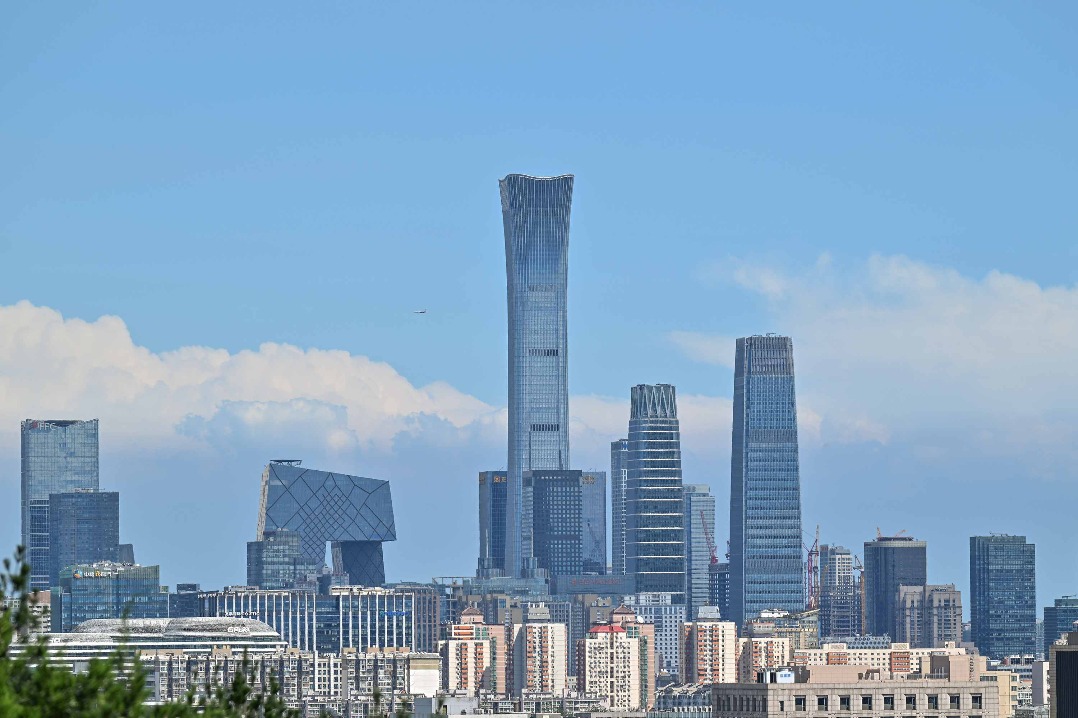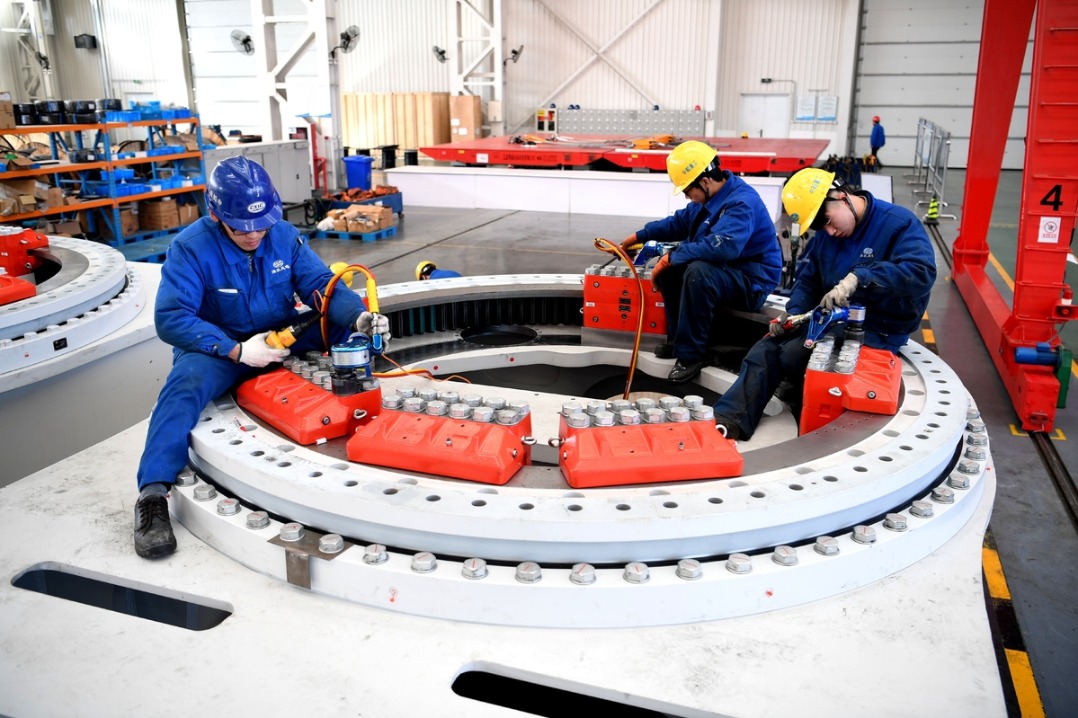Smart cars set to drive auto industry's development


Sensors and software becoming essential components of new vehicles
In summer last year, Sun Congjun replaced his 2012 Mercedes C200 with an electric Xpeng P7.
Once distrustful of the novel functions of such cars, dismissing them as useless, the 45-year-old salesman in Beijing has quickly taken to the model's fancy features.
He is especially drawn to its automatic parking, enabled by an Nvidia chip, four cameras and 12 ultrasonic sensors, among other items.
The seasoned driver said he is good at reversing, but he feels better when the car takes over — looking out for an available parking space and reversing into it — so he can reach for his phone and briefcase, and be ready to exit the vehicle.
"It isn't about time, but it is nice to enjoy what technology can do for you, isn't it?" he said.
Sun is not alone. In the first half of last year, 2.88 million passenger vehicles fitted with driver-assistance systems were sold in China, according to the Ministry of Industry and Information Technology. They accounted for 32.4 percent of all passenger vehicles sold in the nation during that period, with sales up 46.2 percent year-on-year.
Edward Wang, managing director of syndicated research at J.D. Power China, which focuses on consumer insights, data and analytics, said smart features and exciting onboard experiences are becoming increasingly important factors when people are deciding to buy a new car.
"They are not necessarily buying a model solely for those functions, but they certainly would not buy one if it didn't have such functions," he said.
Driver-assistance systems are classified as Level 2 in the Society of Automotive Engineers' six levels of driving automation. Level 0 indicates no automation, while Level 5 means the car has no need for a driver at all.
In addition to parking, Level 2 functions include acceleration or deceleration based on traffic flow, lane departure warnings and autonomous emergency braking systems.
In China, such functions have become must-haves in newly launched models, including affordable compact cars priced at less than 100,000 yuan ($14,370).
Xu Changming, deputy director of the State Information Center, said Generation Z will be the driving force in the development of China's smart vehicle sector. "They have grown up using the internet and artificial intelligence, so they like new technologies," said Xu, who estimated that by 2030 about 35 percent of China's car buyers will have been born after 1995.
Development moves
Carmakers are also stepping up efforts to develop such capabilities and partnering with big-name technology companies.
In November, electric car startup Nio joined with tech giant Tencent to work on high-precision mapping systems for drivers. The deal will allow Nio to use Tencent's cloud computing infrastructure for data storage and training for its driver-assistance and autonomous driving technology.
The partnership came after Xpeng and Alibaba unveiled a computing center in August to train software for its smart vehicles. Xpeng said the center will reduce the training time for its core autonomous driving model from seven days to less than an hour. The startup will also use technology from Alibaba's cloud division for its computing needs.
Xpeng's CEO, He Xiaopeng, a former Alibaba executive, said, "We will need to spend at least 1 billion yuan on computing power annually by 2025."
Both Nio and Xpeng are leading electric car startups in China, considered as rivals to Tesla, and both were among the first to introduce the latest components available for their vehicles.
Nvidia's Drive Orin chip, the world's highest-performance autonomous driving processor, first appeared in Nio's ET7 sedan last year.
William Li, Nio's founder, said, "Our in-house team has developed autonomous driving algorithms run on four industry-leading Nvidia Orin processors, delivering an unprecedented 1,000-plus TOPS (tera operations per second) in production cars."
Developing an autonomous driving system is costly, so some carmakers buy the driver-assistance system from suppliers.
Haomo.ai, an autonomous driving startup backed by China's Great Wall Motors, said its driver-assistance system HPilot has been installed in about 20 models in China, with the combined distance involving the system exceeding 23 million kilometers.
The Wey Mocha, an SUV from Great Wall Motors, is one of the models using the HPilot system. Besides automatic parking, the model can spot traffic lights, change lanes and overtake.
It is China's first mass-produced model to use Qualcomm's Snapdragon Ride, the chipmaker's platform for autonomous driving functions, and 31 sensors including two lidar sensors.
Qiao Xinyu, Wey's deputy general manager, said smart driving will be the decisive factor in the highly competitive new energy vehicle segment.
Meanwhile, Zhang Kai, Haomo's chairman, said that by 2025 up to 70 percent of new vehicles sold in China are expected to be smart vehicles with high-level driver-assistance functions.
German carmaker Volkswagen has established the first subsidiary in China of its software arm Caridad, which develops software ranging from infotainment to autonomous driving.
Dirk Hilgenberg, Cariad's CEO, said in a previous interview with China Daily: "As we all know, the China market is very progressive in automated driving and digital experience. We want to ensure we can serve local customers very well, establishing a company subsidiary that is able to grasp the speed, development and innovation in China for China."
Rather than starting from scratch by itself, Cariad is establishing a joint venture with startup Horizon Robotics, one of China's leading providers of computing solutions for smart vehicles, with investment of 1.3 billion euros ($1.35 billion).
Cariad will hold a 60 percent share in the joint venture that will develop driver-assistance and autonomous driving solutions for its electric models in China.
"The China market is so progressive and customer expectations are high. We need to accelerate our pace of innovation," Hilgenberg said.
Yuan Shengyue, a smart-vehicle expert at carmaker BAIC Bluepark, said China is among the world's leading countries in terms of introducing Level 2 functions into production vehicles.
"Level 2 functions have become commonplace, and many carmakers are working on Level 3 and higher functions," Yuan said.
Meanwhile, German carmaker Mercedes-Benz is in talks with Chinese authorities to introduce its Level 3 system. Also known as "conditional driving automation", Level 3 vehicles can drive themselves in particular conditions so the driver is no longer obliged to constantly watch road conditions.
Japanese carmaker Honda said it would develop technology to enable its Level 3 self-driving capability by the second half of the decade.
Honda engineer Mahito Shikama told reporters during an online briefing, "We believe we can help reduce accidents by pursuing Level 3 technology, which in essence is about cars that do not crash."
The Japanese company is aiming for a zero-fatality rate from traffic accidents involving its cars and motorcycles globally by 2050.
Andrew Grant, senior associate with Bloomberg NEF's Intelligent Mobility team, said Level 2 vehicles are expected to surpass 50 percent of global passenger vehicle sales by 2025. He estimated the peak for Level 2 sales will arrive in 2028, with approximately 53 million vehicles sold.
"While Level 2 vehicles will remain a sizable market, Level 3 vehicles could be even bigger as soon as 2027, with sales of Level 2 and 3 vehicles approaching a combined $150 billion," he said.
Robotaxi services
Driverless technologies are primarily used in robotaxis as well as autonomous buses and trucks in designated areas, rather than private cars that can go anywhere and may encounter unforeseen situations.
In November, technology giant Baidu said it will establish the world's largest autonomous ride-hailing service area as early as this year.
The company, which named its project Apollo, has already rolled out fully driverless ride-hailing services in Wuhan, capital of Hubei province, and in Chongqing.
In about 10 other Chinese cities, it also has fleets with operators in the vehicles, as required by local authorities for safety purposes.
In the third quarter of last year, Apollo completed more than 474,000 rides, up 311 percent year-on-year and a 65 percent increase over the previous quarter.
Chen Jingkai, an autonomous driving expert at the company, said, "Baidu Apollo has created a safe, intelligent and efficient autonomous driving technology system that enables us to bring robotaxi services from designated zones to the open road."
Baidu said it can launch its robotaxi fleets in a new city in just 20 days, as its automated systems generate 96 percent of the maps needed, reducing the workload for human engineers in completing them.
Other companies — including WeRide, Pony.ai and Didi Chuxing — are also running robotaxi fleets and autonomous buses in cities ranging from Beijing to Guangzhou and Shenzhen, both in Guangdong province.
In November, Japanese carmaker Nissan said it will establish a robotaxi fleet in Suzhou, Jiangsu province, with technical support from WeRide.
Hideki Kimata, president of Nissan China Investment, said, "Through the new company, we are aiming to provide all-new riding experiences with easier, more convenient mobility services for more customers in China."
A report by global consultancy IHS Markit said the market for China's robotaxi services is expected to surpass 1.3 trillion yuan by 2030, accounting for 60 percent of the country's ride-hailing market by then.
BloombergNEF estimates that China will operate the world's largest robotaxi fleet, with about 12 million vehicles by 2040, followed by the United States, with around 7 million autonomous vehicles.
In addition to robotaxis, highly automated trucks and buses are being seen in designated areas in China, such as ports and industrial parks.
Inceptio Technology, a Chinese autonomous driving startup, said its fleet of trucks has made trips covering more than 6 million km.
The company, established in Shanghai in 2018, is dedicated to Level 3 and 4 autonomous technologies for trucks. Two models developed in collaboration with Dongfeng and Sinotruk started production late last year.
The startup said it is updating the system and making breakthroughs in its core technology, including algorithms, hardware and data.
Yu Qian, CEO and founder of QCraft, a Chinese autonomous driving startup, said the sector is arriving at a "golden inflection point of growth", with policies becoming increasingly clear and open, and technologies such as 5G and algorithms becoming more powerful.
Updating policies
China is among countries fast updating their policies to facilitate the technology's development. More than 30 provinces and cities have established regulations governing road tests for smart vehicles.
At a meeting in September, Xin Guobin, vice-minister of industry and information technology, said China will roll out more policies and deepen international exchanges to create a better environment for the burgeoning sector.
In November, the ministry unveiled a draft guideline aimed at expanding road tests for autonomous driving vehicles nationwide, while Beijing offered permits to allow companies to move their safety operators from behind the steering wheel to the back seat of their test vehicles in designated zones in the capital.
Although human operators are still required, the move marks a significant step toward the commercialization of fully self-driving technology, experts said.
Auto suppliers are also working hard to keep up with demand for autonomous vehicles.
Statistics from research institute Gaogong show that more than 74,200 lidar sensors, the most expensive such devices used in vehicles, were installed in the first 10 months of last year, compared with less than 10,000 in the same period of 2021.
The sensors were mostly fitted by Chinese companies Livox and Hesai, as well as Innovusion, based in Silicon Valley in the United States. Gaogong expects the figure to reach 400,000 to 500,000 units in China this year.
In August, German auto parts supplier ZF said it will invest 320 million yuan to expand a plant in Shanghai to produce electric steering systems, which the company said can support autonomous driving functions at different levels.
Tiremaker Goodyear said it has been working with autonomous driving companies, including TuSimple, to provide tires and tire management solutions.
Pietro Saletta, vice-president of consumer business, Goodyear Asia-Pacific, said, "Tires are the only things on a vehicle that touch the ground and it's this critical position that can help us enable future mobility solutions."
lifusheng@chinadaily.com.cn





































